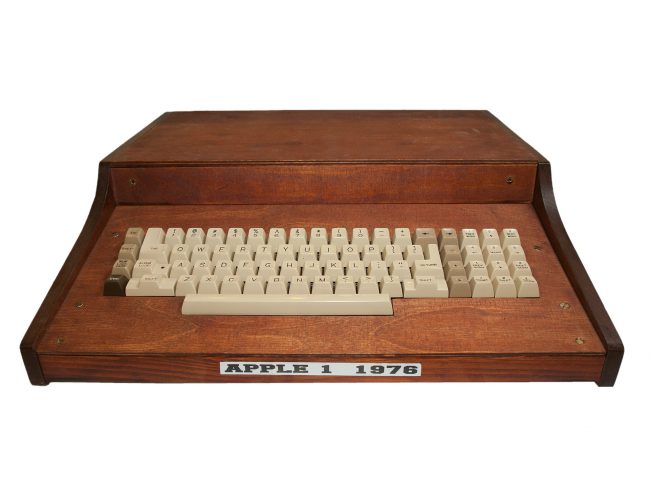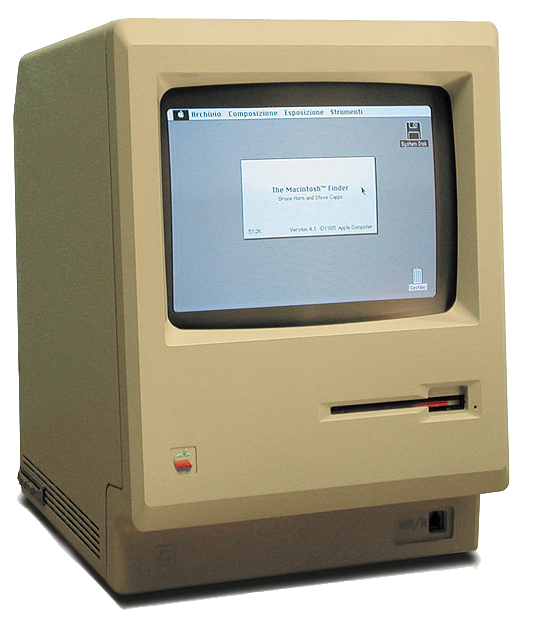![By MetalGearLiquid, based on File:Steve_Jobs_Headshot_2010-CROP.jpg made by Matt Yohe [CC BY-SA 3.0 (http://creativecommons.org/licenses/by-sa/3.0)], via Wikimedia Commons](http://scihi.org/wp-content/uploads/2017/02/Steve_Jobs_Headshot_2010-CROP2-397x600.jpg?_t=1645644657)
Steve Jobs (1955-2011)
On February 24, 1955, American businessman, inventor, and industrial designer Steve Jobs was born. Jobs is widely recognized as a pioneer of the microcomputer revolution of the 1970s and 1980s, along with Apple co-founder Steve Wozniak.
“What a computer is to me is it’s the most remarkable tool that we have ever come up with. It’s the equivalent of a bicycle for our minds.”
— Steve Jobs, as quoted in Memory and Imagination: New Pathways to the Library of Congress (1991)
Early Years
Steve Jobs was born in San Francisco and adopted at birth; he was raised in the San Francisco Bay Area by adoptive parents in Cupertino, California, located in what is now known as Silicon Valley. Though he was interested in engineering, his passions of youth varied. When he was 13 in 1968, Jobs was given a summer job by Bill Hewlett (of Hewlett Packard) after Jobs cold-called him to ask for parts for an electronics project. He dropped out of Reed College, in Portland, Oregon, took a job at Atari Corporation as a video game designer in early 1974, and saved enough money for a on a seven-month spiritual quest to India to experience Buddhism, where he contracted dysentery.
Homebrew Computer Club and Apple I
Back in Silicon Valley in the autumn of 1974, Jobs reconnected with Stephen Wozniak, a former high school friend who was working for the Hewlett-Packard Company. Jobs and Wozniak attended meetings of the Homebrew Computer Club in 1975. When Wozniak told Jobs of his progress in designing his own computer logic board, Jobs suggested that they go into business together, which they did after Hewlett-Packard formally turned down Wozniak’s design in 1976. The Apple I, as they called the logic board, was built in the Jobses’ family garage with money they obtained by selling Jobs’s Volkswagen minibus and Wozniak’s programmable calculator.[1] Jobs was one of the first entrepreneurs to understand that the personal computer would appeal to a broad audience.[4] Jobs chose the Apple logo, an apple with a bite taken out of it, because he thought the other design option, a whole apple, looked too much like a cherry.[5]

Apple I in a typical self-built case at that time
Apple II, Lisa, and Macintosh
With Jobs’s encouragement, Wozniak designed an improved model, the Apple II, complete with a keyboard, and they arranged to have a sleek, molded plastic case manufactured to enclose the unit.[4] In 1977, Jobs and Wozniak introduced the Apple II at the West Coast Computer Faire. It was the first consumer product sold by Apple Computer and was one of the first highly successful mass-produced microcomputer products. In 1981 the company had a record-setting public stock offering, and in 1983 it made the quickest entrance (to that time) into the Fortune 500 list of America’s top companies. In 1979 Jobs led a small group of Apple engineers to a technology demonstration at the Xerox Corporation’s Palo Alto Research Center (PARC) to see how the graphical user interface could make computers easier to use and more efficient. Soon afterward, Jobs left the engineering team that was designing Lisa [1], a business computer, to head a smaller group building a lower-cost computer. Both computers were redesigned to exploit and refine the PARC ideas, but Jobs was explicit in favoring the Macintosh, or Mac, as the new computer became known [3]. In January 1984 Jobs himself introduced the Macintosh in a brilliantly choreographed demonstration that was the centerpiece of an extraordinary publicity campaign. It would later be pointed to as the archetype of “event marketing.” [4]

The Apple Macintosh (1984)
From NeXT to Pixar
Due to tensions in the company caused by the Macintosh’s failure to defeat the IBM PC, in 1985 CEO John Sculley convinced Apple’s board of directors to remove the company’s famous cofounder. Jobs quickly started another firm, NeXT Inc., designing powerful workstation computers for the education market. Although the NeXT computer was notable for its engineering design, it was eclipsed by less costly computers from competitors such as Sun Microsystems, Inc. In 1986, Jobs funded the spinout of The Graphics Group (later renamed Pixar) from Lucasfilm‘s computer graphics division. The first film produced by Pixar with its Disney partnership, Toy Story (1995), with Jobs credited as executive producer, brought fame and critical acclaim to the studio when it was released. Over the next 15 years the company produced box-office hits as e.g. Monsters, Inc. (2001); Finding Nemo (2003); The Incredibles (2004); Ratatouille (2007); WALL-E (2008); Up (2009). Finding Nemo, The Incredibles, Ratatouille, WALL-E, Up and Toy Story 3 each received the Academy Award for Best Animated Feature. Jobs eventually sold the studio to the Disney Company in 2006.
Back in the Business – The iMac
In late 1996, Apple was pressed by huge financial losses and on the verge of collapse, and with their newly hired chief executive Gilbert Amelio decided to replace the Macintosh’s aging operating system with NEXTSTEP, developed by Steve Jobs for his NeXT computer, bringing Jobs back to Apple as a consultant. However, in 1997 Jobs was asked to lead the company once again. By forging an alliance with the Microsoft Corporation, simplifying the company’s product line, and engineering an award-winning advertising campaign, he finally succeeded to save Apple. In 1998, Jobs introduced the iMac, an egg-shaped, one-piece computer at a relatively modest price and initiated a trend of fashionable computers. By the end of the year, the iMac was the highest-selling personal computer in the U.S. By introducing a stylish iBook, a laptop computer intended for students, and the powerful G4 desktop computer Jobs reestablished himself as a master high-technology marketer and visionary.[4]
iTunes, iPod, and iPhone
The company subsequently branched out, introducing and improving upon other digital appliances. With the introduction of the iPod portable music player, iTunes digital music software, and the iTunes Store, the company made forays into consumer electronics and music distribution. On June 29, 2007, Apple entered the cellular phone business with the introduction of the iPhone, a multi-touch display cell phone, which also included the features of an iPod and, with its own mobile browser, revolutionized the mobile browsing scene.
In October 2003, Jobs was diagnosed with cancer which lead to his resignation as Apple’s CEO in 2011 and finally to his death on October 5, 2011.
Jean-Charles Evrard, Steve Jobs MIT Class: What he learnt after he was fired from Apple? [8]
References and Further Reading:
- [1] Who remembers Apple’s Lisa?, SciHi Blog, January 19, 2014.
- [2] Apple 1 and the Homebrew Computer Club, SciHi Blog, April 1, 2013.
- [3] The Macintosh 128K making history with George Orwell, SciHI Blog, January 24, 2018.
- [4] Steve Jobs, American businessman, at Britannica Online
- [5] Brandon Griggs, Doug Gross and Mark Milian, The best tidbits from the Steve Jobs bio, CNN, October 26, 2011
- [6] David Packard and Hewlett-Packard, SciHi Blog, September 7, 2017.
- [7] Steve Jobs at Wikidata
- [8] Jean-Charles Evrard, Steve Jobs MIT Class: What he learnt after he was fired from Apple? , Jean-Charles Evrard @ youtube
- [9] Timeline for Steve Jobs, via Wikidata





